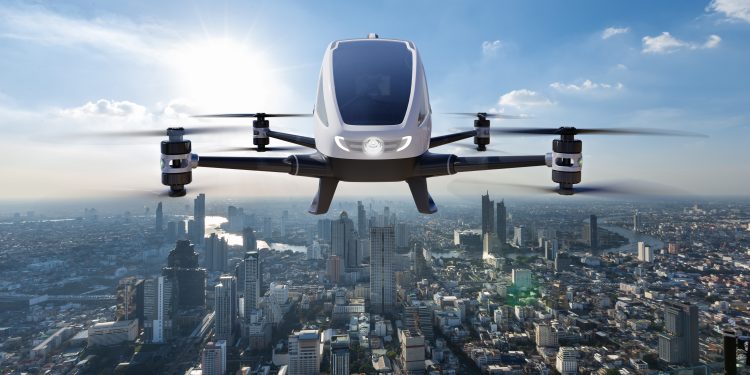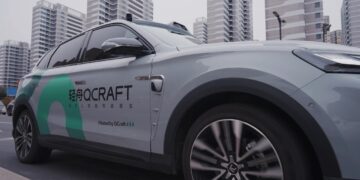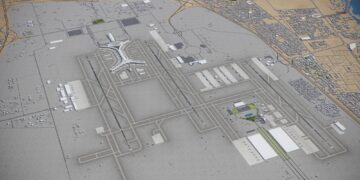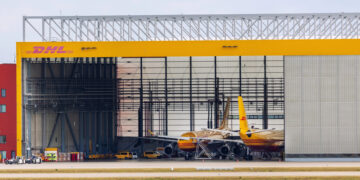The once fictional concept of flying taxis is now teetering on the threshold of actualization, thanks to breakthroughs in aviation technology and substantial investments from both established corporations and entrepreneurial ventures. These aerial innovators are anticipated to revolutionize not only personal commuting but also the realms of logistics and supply chain management as cities swell and the need for swift, efficient transport escalates.
For those in the logistics sector, the promise of flying taxis stretches beyond simply ferrying passengers. These avant-garde crafts are expected to streamline supply chain processes, augment delivery rates, and diminish the environmental toll. Nonetheless, the amalgamation of flying taxis into current logistic systems brings about a unique mixture of challenges and prospects.
Technological advancements in air transit
Flying taxis, also known as electric vertical takeoff and landing (eVTOL) aircraft, symbolize a substantial stride towards urban air mobility. These crafts are engineered for a new paradigm of transportation that is efficient, hushed, and sustainable.
At the crux of flying taxis is the electric propulsion mechanism, enabling them to ascend and descend vertically. These apparatuses typically involve an array of rotors or pivoting-rotor configurations, providing necessary lift and propulsion. Electric propulsion is not only silent compared to conventional combustion engines but also more eco-friendly, aiding in the reduction of both air pollution and noise within cityscapes.
Aviation electronics, or avionics, are integral for the navigation and operation of flying taxis, encompassing GPS for live positioning, collision evasion systems, and advanced autopilot functionalities for autonomous or semi-autonomous flight. This integration of technology ensures secure and competent navigation, especially within densely populated urban areas.
The operability of flying taxis is heavily reliant on battery advancements. Present developments in lithium-ion batteries furnish the requisite energy density for flights of approximately 60 miles at velocities near 150 mph. Companies are constantly exploring methods to lengthen battery duration and curtail charging intervals, enhancing the practicality of flying taxis for everyday usage.
Several leaders in the industry are propelling the flying taxi revolution, each contributing unique designs and technological innovations.
Archer Aviation is set to commercially introduce its Maker aircraft in 2024, a two-passenger eVTOL conceived for urban air travel, capable of covering up to 60 miles. Archer is also in the process of developing a four-passenger variant aimed at offering a rideshare service similar to Uber. Their investment in extended reality (XR) for virtual flight previews highlights their dedication to state-of-the-art innovation.
Volocopter’s VoloCity air taxi, another notable contender, is designed for the urban landscape with an 18-rotor system. The VoloCity is tailored for short hops of 20 to 30 kilometres at speeds between 90 to 100 km/h. Volocopter’s collaborations with various parties to integrate their air taxis with current transportation systems exemplify their potential, with demonstrations planned for events such as the Paris 2024 Olympics.
Joby Aviation is making waves with its ambition to launch the globe’s inaugural commercial flying taxi service in Dubai, in collaboration with Dubai’s Road and Transport Authority (RTA). Joby’s aircraft are crafted for both passenger and cargo conveyance, which underscores their adaptability in urban logistics.
Lilium is pioneering an eVTOL jet with a fixed-wing format and 36 electric jet engines, promising higher speeds and longer distances, making it apt for travel within and between cities. Lilium’s focus on scalability and efficiency earmarks them as an influential player in the arena of urban air mobility.
Supply chain assimilation
Flying taxis present a myriad of prospective applications within the logistics and supply chain sectors, potentially boosting efficiency, particularly in traffic-ridden urban zones with constrained road networks.
These aerial vehicles can revolutionize last-mile delivery by circumventing road congestion, guaranteeing swifter delivery times and lessening traffic. They are perfectly suited for dispatching precious, urgent goods directly to urban distribution points or customer premises.
For enterprises with various facilities within a city, flying taxis can offer speedy and effectual transfers of merchandise between locations, streamlining operations, diminishing lead times, and enhancing inventory management.
In exigent circumstances like medical crises or disaster relief efforts, flying taxis can swiftly and efficiently transport critical supplies, medications, and personnel. Their capability to reach otherwise inaccessible areas renders them invaluable in such situations.
Assimilating flying taxis into the supply chain proffers several advantages:
- Speed and efficiency: Flying taxis can notably curtail delivery periods, particularly within congested urban regions, which can heighten customer satisfaction and bolster service quality.
- Environmental impact: Electric propulsion systems enable flying taxis to generate fewer emissions than standard delivery vehicles, promoting more sustainable logistics operations and aiding in the attainment of corporate environmental goals.
- Cost savings: Despite the steep initiation costs for flying taxi infrastructure, the long-term economization from decreased fuel expenditures, lesser maintenance needs, and augmented operational efficiency can be significant.
- Flexibility and scalability: The pliability of flying taxis allows for adjustments according to fluctuating demands, which is vital for managing peak times and variable delivery volumes without substantial holdups.
Cost-benefit scrutiny of flying taxis
The substantial initial investment to merge flying taxis into the logistics supply chain is notable. This encompasses expenditures for acquiring eVTOL crafts, constructing vertiports, and establishing the requisite support structures for upkeep and charging. An individual eVTOL may cost between $1 million to $3 million based on its model and features. Furthermore, erecting vertiports in urban locales could demand sizable investments in land, construction, and regulatory adherence.
Operational expenditures for flying taxis include upkeep, energy consumption, pilot wages (if applicable), and insurance. eVTOLs are projected to incur lower maintenance costs due to their simplified electric mechanisms, though they remain considerable. Energy costs, chiefly for recharging batteries, are recurrent. If the flying taxis are operated autonomously, this could diminish labor costs; however, fully autonomous technology is not yet fully perfected, hence pilot salaries continue to be a consideration.
Notwithstanding the steep startup and ongoing costs, the return on investment and enduring benefits of incorporating flying taxis into the logistics supply chain can be immense.
Integrating flying taxis into the supply chain offers a glimpse into the logistics of tomorrow, where swiftness, efficiency, and sustainability merge. While facing notable initial investments and operational hurdles, the prospects of quicker deliveries, reduced congestion, and diminished environmental impact render it an enthralling innovation. As the technologies advance and infrastructures evolve, flying taxis are poised to become an integral part of urban logistics, transforming the modalities of goods transport and delivery in our increasingly crowded metropolises. The voyage to this new frontier is replete with both prospects and challenges, but the vision of a more prolific and eco-conscious supply chain is well worth the pursuit.









